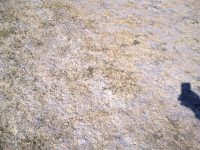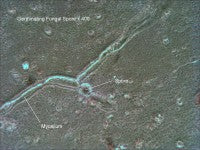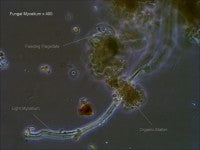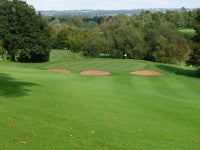Turf diseases spoiling your sward?

In previous articles, we have looked at ways of reducing inorganic inputs and creating healthy rootzones to improve the quality of playing surfaces and, in the case studies of turf managers implementing healthy soil management practices, you will have noted that the incidence of plant diseases and fungicide use is substantially reduced when you manage grass grown in healthy soil.
Turf diseases are almost unknown on natural grasslands and study of the plants and rootzones of healthy grass has shown how nature helps plants become disease resistant. We now know how to recreate many of the natural defence mechanisms against diseases in sports turf rootzones to the benefit of the plant, players and company purse.
Plants provide the food for the tonnes of microbial life that live in every hectare of healthy soil. If the plant dies, the microbes lose their source of food so, over millions of years, plants and microbes have developed a variety of defence mechanisms to keep the plant alive.
Arm the battlements

When a plant comes under attack, pathogenic fungi will invade the plant through wounds, pores or by producing enzymes that break down the cell wall. In nature, plants have coexisted with the diseases that attack them for millions of years and have developed a range of defence mechanisms that come into play as soon as the plant comes under attack.
The plant senses what is happening and responds by producing toxic chemicals and pathogen degrading enzymes, some of which produce hormones called phytoalexins which flood the attack site and act as toxins to kill the invading pathogen.
Greenkeepers can stimulate the grass to produce these immune responses and phytoalexin production by using biostimulants with the organic acids and chitin that help stimulate this response.
Good microbes to the rescue
Ask any turf manager to name soil fungi and a few well known pathogens - fusarium, anthracnose and take all patch usually come at the top of the list - but they understandably ignore the many thousands of fungi and bacteria species that form beneficial symbiotic relationships with plants. Soil microbes rely on the host plant for food and survival, so they have evolved many excellent mechanisms to ensure their benefactor stays alive.

There is no reason for the microbes to be missing. Aerobic beneficial soil microbes are killed by the high salt content of inorganic fertilisers, lack of oxygen and insufficient humus and humic compounds from degraded thatch on which to live. Reducing the use of inorganic fertilisers, increasing aeration and applying the correct biostimulants will enable soil microbes to survive and thrive. There are many commercially available inoculants and the use of compost teas to regularly inject the rootzone with a wide range of bacteria, fungi, protozoa and beneficial nematodes is becoming standard practice on golf courses, including many of Europe's major championship venues.
Let us explore how the soil microbes can form a very strong line of defence against most common diseases of fine turf.
Barriers
Many beneficial fungi and bacteria, especially fungi that form mycorrhizal associations, form a barrier around the root, they simply stop any pathogen from getting near to the root system and invading the plant. The root leaks proteins and carbohydrates, which are the primary source of food for soil bacteria, which then convert the protein into plant available nutrient. If bacteria and fungi are not present in sufficient numbers, the first line of defence is quickly breached and the pathogenic fungi can attack the plant.

Exclusion
Many plant pathogens live in beneficial form in the soil until the plant shows stress or becomes weakened by climatic conditions, over fertilisation or the defence mechanisms fall down and the pathogen sees an easily available food source. If you have enough good microbes, they will starve the pathogens of food, preventing them from growing. This is why it is so important to degrade thatch and convert it to humus by colonising the thatch layer with good fungi and bacteria, because thatch is the substrate on which a lot of pathogenic fungi like to live.
Toxin production
When the host comes under attack, the plant sends out a signal to the surrounding microbes and some produce toxins that will kill the pathogen. These toxins form the basis for the latest fungicide technology and are found in strobilurin fungicides which were developed from observing how mushrooms prevented disease. Azoxystrobin is the best known in the turf industry. They work by stopping the pathogens energy supply. However, soil microbes produce these toxins for free when they receive signals from the host plant or become aware of the presence of a pathogen.
Predation
Simply put, microbes eat each other. They are tiny microscopic organisms that just represent a food source for each other. Therefore, if you have a predominance of beneficial bacteria, fungi and predatory nematodes, some of the harmful fungi and root feeding nematodes will get eaten.
Some sports turf swards are naturally disease free but, for many turf managers, the objective is to break the fertiliser - water - disease - fungicide - fertiliser cycle.
The question is how to introduce these defence systems and how to keep them alive?
The USGA specification green or sand sports pitch is usually too low in organic matter to support a diverse microbial population so, in most cases, microbes have to be added and then fed biostimulants to keep them alive.
Thatch is a food source for both beneficial and pathogenic fungi, so the first stop is to degrade the thatch and convert it to humus, humin compounds and humic and fulvic organic acids which give soil its colour and earthy smell. Degrading thatch removes the food source for surface living pathogens and creates a humus rich rootzone to support a diverse microbial population that form a barrier around the root system. See https://www.pitchcare.com/magazine/thatch-your-friend-and-food-for-fine-grass.html for more information on the benefits of thatch degradation.
Specific bacteria and fungi may be applied in liquid or granular form by themselves or combined with fertilisers, seed coats or biostimulants.
Compost teas are becoming the method of choice for many greenkeepers because you get the widest variety of microbes which are grown on site in a simple brewer, reducing the cost. Compost teas can be sprayed monthly with all the biostimulants and organic fertilisers needed, reducing machine time and man hours.
USGA or sand rootzones are usually low in beneficial organic matter (thatch is organic material) to act as a biostimulant (see https://www.pitchcare.com/magazine/biostimulants.html for more information on biostimulants ) but, as a general rule, the microbiology in the soil and plant needs carbohydrates and fulvic acids in spring, humic acids and seaweeds in summer and fulvic acids, potassium silicate and seaweed from late summer until dormancy.
Given the construction and stresses placed upon the grass on a heavily used sports turf, it is rare to go for a whole year without the need for a fungicide in an IPM programme but, if you get nature's army on your side, the job becomes a lot easier and costs fall as you grow healthier plants in healthier soil with less fertiliser and pesticide use.

We used to apply fungicides up to eight times per year for a variety of diseases. In 2010, we started by degrading our thatch and then applied compost teas to increase the friability of our rootzone.
Since reducing thatch and improving rootzone quality, we have seen an increase in perennial grasses but, most importantly, the need for fungicide applications has steadily reduced to one in 2015, with limited spot treatments.
We still get small specks of fusarium but, left untreated, they grow out in a few days.
Symbio is dedicated to researching solutions to restoring the natural biological activity in soils and growing media essential to ensure the long term sustainability of food production and amenity plant resources for the world's increasing population.
E: martin@symbio.co.uk
T: 01428 685762
W: www.symbio.co.uk
